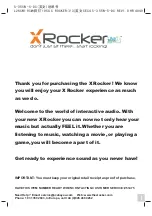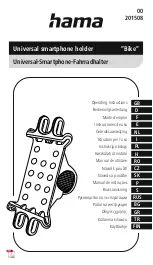
Step 3.
Check the sharpness of your blade by cutting a piece of paper or a fruit or vegetable. If
additional sharpening is needed, repeat process until sharp but make sure to clean your knife
before continuing. If sharp, turn off power to the machine.
Initial edge setting and/or sharpening extremely dull or damaged Outdoor Sport Style
knives (i.e. Hunting/Fishing/Camping), Tactical knives, or everyday pocket knives with
a grind on both sides
”Outdoor Sport Style Knives” is defined as knives used in sporting activities with an angle of 20 – 30
degrees on each side (40 – 60 degrees combined).
“Tactical Knives” is defined as knives primarily designed for utility/tool use but can also be used in
close combeat by military/law enforcement. Angles for Tactical knives normally range from 25 – 30
degrees on each side (50 – 60 degrees combined).
“Everyday Pocket Knives” is defined as a small size folding knife with one or more blades that fold into
the handle and may be used for anything from opening an envelope to slicing an apple. Most angles
of Pocket Knives range from 20 – 30 degrees on each side (40 – 60 degrees combined).
NOTE:
You must first set the initial cutting edge of your knife to the appropriate angle of
the interlocking ceramic wheels before sharpening your blade in the electric sharpening
slot. This is a one-time process that will not be required for re-sharpening or light honing.
You will also have to use this process if your blade ever gets damaged or extremely dull.
Step 1.
Insert the heel portion of your blade into the manual slot marked
CARBIDE
and pull through from heel to tip (never back and forth). Moderate
downward pressure is all that is required when pulling the knife through
the slot and lift the knife handle in the curve portion of the blade to sharpen
all the way out to the tip. Use a smooth, consistent stroke when pulling
the knife through the slot at a speed of 1 second per 2 inches. Repeat a
minimum of 20 times. After 20 pulls, the knife should begin to pull thru the
slot smoothly. If not, additional pulls are required.
NOTE: Knives made of
extremely hard steel may require up to 50 pulls through the slot when setting the initial
edge.
Step 2.
Once the initial edge is set using the
CARBIDE
slot, turn on the power to the interlocking
ceramic wheels. Insert the heel portion of the knife blade into the slot and
lower the blade to make contact with the interlocking wheels. When your
blade contacts the wheels and self-aligns itself between the two wheels,
pull through slot from heel to tip (never back and forth) at a speed of 1
second for every 2 inches of the blade. Moderate downward pressure is
all that is required and lift the handle at the end to sharpen all the way out
to the tip of the blade. Use a smooth, consistent stroke when pulling the
blade through the slot.
Step 3.
Repeat a minimum of 20 times.
NOTE:
Knives made of extremely hard steel may
require up to 50 pulls through the slot when sharpening the edge.
Step 4.
Check the sharpness of your blade by cutting a piece of paper or a fruit or vegetable. If
additional sharpening is needed, repeat process until sharp but make sure to clean your knife
before continuing. In most instances, you will only need to repeat Steps 2-4. In rare cases, if your
knife is severely damaged and extremely dull, you may need to repeat Steps 1-4 again. If knife
is sharp, be sure to turn off power to the machine.
Step 2
Step 1
NOTE:
This process requires use of the electric sharpening slot ONLY and should be
applied to moderately dull blades or if you are just maintaining an already sharp blade.
Smith’s recommends always performing a light touch up of your knife before each use.
Step 1.
Turn on power to the interlocking wheels. Insert the heel portion of your blade into the
slot and lower blade to make contact with the interlocking ceramic wheels.
When your blade contacts the wheels and self-aligns itself between the two
wheels, pull through slot from heel to tip (never back and forth) at a speed of
1 second for every 2 inches of the blade. Moderate downward pressure is
all that is required and lift the handle at the end to sharpen all the way out to
the tip of the blade. Use a smooth, consistent stroke when pulling the blade
through the slot.
Step 2.
Repeat a minimum of 10 times.
NOTE:
Knives made of extremely hard steel may
require additional pulls through the slot when sharpening the edge.
Step 3.
Check the sharpness of your blade by cutting a piece of paper or a fruit or vegetable. If
additional sharpening is needed, repeat process until sharp but make sure to clean your knife
before continuing. If sharp, turn off power to the machine.
Sharpening any type of Serrated Edge Knife with a grind on one side or both sides
Step 1.
Insert the serrated portion of your blade into the manual slot marked
SERRATED
and
pull through slot from start of serrations to the end. Moderate downward pressure is all that is
required when pulling the knife through the slot because the blade has to be able to lift and fall
as it follows the shape of the serration. Use a smooth, consistent stroke when pulling the knife
through the slot at a speed of 1 second for every 2 inches of the blade. You will feel the blade
lightly bouncing as you pull it through the sharpening slot. This is normal and to be expected.
Repeat a minimum of 10 times.
NOTE:
Knives made of extremely hard steel may require
additional pulls through the slot when sharpening the serrated edge.
Step 2.
Check the sharpness of your serrations. If additional sharpening is needed, repeat the
process until sharp.
Step 1
Re-sharpening or light honing of Outdoor Sport Style knives (i.e. Hunting/Fishing/
Camping), Tactical knives, or everyday pocket knives with a grind on both sides






































